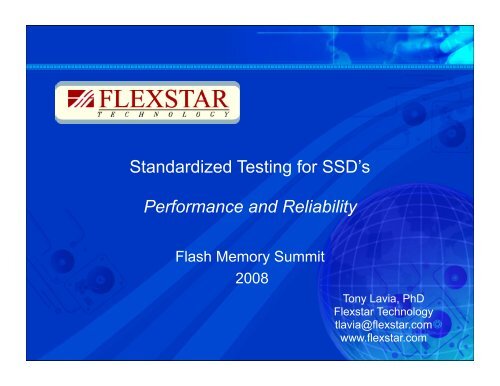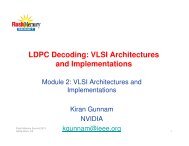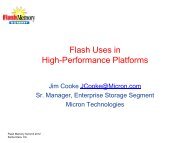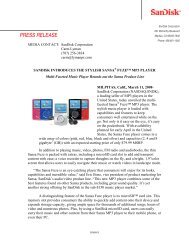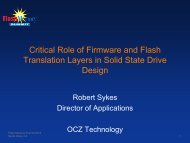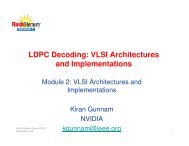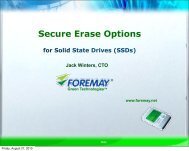Performance and Reliability - Flash Memory Summit
Performance and Reliability - Flash Memory Summit
Performance and Reliability - Flash Memory Summit
You also want an ePaper? Increase the reach of your titles
YUMPU automatically turns print PDFs into web optimized ePapers that Google loves.
St<strong>and</strong>ardized Testing for SSD’s<br />
<strong>Performance</strong> <strong>and</strong> <strong>Reliability</strong><br />
<strong>Flash</strong> <strong>Memory</strong> <strong>Summit</strong><br />
2008<br />
Tony Lavia, PhD<br />
Flexstar Technology<br />
tlavia@flexstar.com<br />
www.flexstar.com
Agenda<br />
<strong>Performance</strong> & <strong>Reliability</strong> Testing<br />
• Why Test<br />
• What is St<strong>and</strong>ardized Testing<br />
• <strong>Performance</strong> & <strong>Reliability</strong> Testing<br />
• Device Specific <strong>Reliability</strong> Tests<br />
• Storage Test Evolution
• Engineering Verification<br />
– EVT DVT etc<br />
– Development debug<br />
• OEM Qualification<br />
– Systems qualification<br />
– <strong>Performance</strong> evaluation<br />
– <strong>Reliability</strong> gauge<br />
• Device Manufacturing<br />
– Meet specifications<br />
– <strong>Reliability</strong> / early life failures<br />
– Fast failure analysis<br />
– ORT<br />
• Field<br />
– Failure analysis<br />
– RMA confirmation<br />
Why Test?
• Engineering Verification<br />
– EVT DVT etc<br />
– Development debug<br />
• OEM Qualification<br />
– Systems qualification<br />
– Comparative analysis<br />
– <strong>Performance</strong> evaluation<br />
– <strong>Reliability</strong> gauge<br />
• Device Manufacturing<br />
– Meet specifications<br />
– <strong>Reliability</strong> / early life failures<br />
– Fast failure analysis<br />
– ORT<br />
• Field<br />
– Failure analysis<br />
Why St<strong>and</strong>ardized Tests?
Key Features of St<strong>and</strong>ardized Testing<br />
• Accuracy<br />
• Repeatability<br />
– Ability to reliably recreate same test<br />
conditions globally<br />
• Tight control over test conditions<br />
– Environmental<br />
– Test tool environment<br />
• Scripting Based Tests<br />
– Suits individual product requirements<br />
– Easily sharable<br />
• Ability to debug in place<br />
– Interrogate / Trace failure conditions<br />
– Remote testing/debugging<br />
• Provides Data Collection & Correlation<br />
– Consistency across the industry<br />
St<strong>and</strong>ardized Testing<br />
Rate (KB/s)<br />
70,000.0<br />
55,937.5<br />
41,875.0<br />
27,812.5<br />
13,750.0<br />
Serial Number VNRD2AC4CGVRHS<br />
1<br />
27<br />
53<br />
79<br />
105<br />
131<br />
157<br />
183<br />
209<br />
235<br />
261<br />
287<br />
313<br />
339<br />
365<br />
391<br />
417<br />
443<br />
469<br />
495<br />
521<br />
547<br />
573<br />
599<br />
625<br />
651<br />
677<br />
703<br />
729<br />
755<br />
781<br />
807<br />
833<br />
859<br />
885<br />
911<br />
937<br />
963<br />
989<br />
Rate (KB/s)<br />
70,000<br />
52,500<br />
35,000<br />
17,500<br />
0<br />
Test Points<br />
Serial Number VN6J3ECFEDBGND<br />
<strong>Performance</strong><br />
1 22 48 74 105 141 177 213 249 285 321 357 393 429 465 501 537 573 609 645 681 717 753 789 825 861 897 933 969<br />
Test Points<br />
<strong>Performance</strong>
Stop the questioning & finger pointing<br />
by st<strong>and</strong>ardizing<br />
The benefits of st<strong>and</strong>ardized, independent test systems<br />
– Known test hardware<br />
– Unbiased <strong>and</strong> fair<br />
– Repeatable test solutions<br />
– Common test scripts<br />
– Industry st<strong>and</strong>ard interfaces<br />
– Correlation between<br />
manufactures <strong>and</strong> OEM’s<br />
– Speeds failure analysis<br />
– Investment protection through<br />
upgradability
SSD Design & Manufacturing<br />
– Design Verification<br />
– <strong>Reliability</strong> Demonstrations<br />
– <strong>Performance</strong> tuning<br />
– Firmware tuning, etc.<br />
Two views of the same drive<br />
QualificationTesting<br />
– Full HDD equivalence<br />
– Multi vendor comparisons
Test Evolution<br />
Note: There is a dramatically different test<br />
focus between existing HDD <strong>and</strong> SSD<br />
devices……except in the qualification<br />
cycle!
Within each test<br />
environment<br />
(qualification or DVT)<br />
multiple views are<br />
evaluated.<br />
Design & Manufacturing<br />
Field & <strong>Reliability</strong><br />
SSD Test Environments
Root Cause<br />
– Design/Components/DRAM<br />
– Component Failures / i.e.<br />
red phosphourous<br />
– Head/Media instability<br />
– Design margin<br />
<strong>Reliability</strong> Testing<br />
HDD design verification / qualification<br />
( rotational media)<br />
Test Process<br />
⇒ Pattern reads/writes/verify<br />
⇒ Power cycling<br />
⇒ Extended test at temperature<br />
⇒ Voltage margining<br />
⇒ Temperature Cycling<br />
⇒ Voltage margining & 4 corner
HDD field reliability<br />
(variable factors in rotational media)<br />
Root Cause<br />
– Contamination<br />
– H<strong>and</strong>ling, head laps<br />
– Lube issues<br />
– Motor bearings<br />
– Growing defect lists<br />
<strong>Reliability</strong> Testing<br />
Test Process<br />
⇒ Multiple full media R/W.<br />
⇒ Head/Surface defects<br />
⇒ W/R adjacent tracks<br />
⇒ Dwell at elevated temperature
– Endurance<br />
Root Cause<br />
– <strong>Performance</strong>-mfg. variability<br />
– Bit failures / Data Retention<br />
– Component Failures<br />
– Write splice<br />
– Metadata corruption<br />
– Write performance<br />
– Erase failures<br />
– Design Margin<br />
<strong>Reliability</strong> Testing<br />
SSD design verification / qualification<br />
Test Process<br />
⇒ Multiple writes<br />
⇒ <strong>Performance</strong> verification<br />
⇒ Disturb testing / pattern writes<br />
⇒ Temperature Cycling<br />
⇒ Voltage margining & 4 corner<br />
⇒ Power cycling mid writes<br />
⇒ R<strong>and</strong>om I/O w/ power cycling<br />
⇒ Cold write<br />
⇒ Margined erase<br />
⇒ Four Corners
Root Cause<br />
– Wear leveling performance<br />
– Data Retention<br />
– Reallocation errors<br />
SSD testing for field reliability<br />
<strong>Reliability</strong> Testing<br />
Test Process<br />
⇒ Fragmentation tests<br />
⇒ Temperature & power cycling<br />
⇒ RW tests w/ power cycling<br />
⇒ Write splice, cold writes
•What Tests should I run?<br />
•Should cover Functional capabilities of DUT<br />
•Which Comm<strong>and</strong>s Sets supported?<br />
•Exercise DUT in modes likely to cause problems<br />
Sample Testing Criteria<br />
1. Read / Write Comm<strong>and</strong>s<br />
2. Power Management Comm<strong>and</strong>s<br />
3. Automatic Acoustic Management comm<strong>and</strong>s<br />
4. 28 Bit Addressing<br />
5. 48 Bit Addressing<br />
6. Queued Comm<strong>and</strong>s<br />
7. SMART comm<strong>and</strong>s<br />
8. Packet comm<strong>and</strong>s<br />
9. CFA comm<strong>and</strong>s<br />
08/20/08<br />
10. Security comm<strong>and</strong>s<br />
11. Removable Media comm<strong>and</strong>s<br />
12. Device Configuration Overlay comm<strong>and</strong>s<br />
13. Streaming Comm<strong>and</strong>s<br />
14. Media Card Pass Through comm<strong>and</strong>s<br />
15. General Purpose Logging comm<strong>and</strong>s<br />
16. Host Protected Area comm<strong>and</strong>s.<br />
17. Other optional comm<strong>and</strong>s<br />
15
What the Customer Expects<br />
(in a world of tests developed by key OEMs)<br />
SSD vs HDD<br />
• Complete functional equivalence <strong>and</strong> independence.<br />
• Interface testing<br />
• <strong>Reliability</strong> demonstration<br />
• <strong>Performance</strong> demonstrations<br />
• Endurance demonstration<br />
• Power on / spin-up / sleep / resume from sleep<br />
compliance.
Thank You<br />
Tony Lavia, Flexstar Technology<br />
For additional questions, please feel free to follow up<br />
with me in booth #202
Sample Tests<br />
08/20/08 ? = Device Dependant Supported<br />
18
SSD Test Suite Overview<br />
• This test suite is composed of six SSD-specific<br />
P25 test scripts plus two Java Plug-in “class” files<br />
that are called from some of the scripts.<br />
• The scripts are examples of tests important to all<br />
SSD manufacturers <strong>and</strong> their customers. They are<br />
run on a FLEXSTAR test system: the tests include<br />
raw performance (transfer rate <strong>and</strong> NCQ),<br />
reliability, power consumption <strong>and</strong> wear leveling.<br />
• Flexstar encourages the to adopt these test<br />
scripts as their st<strong>and</strong>ard. These scripts can be<br />
modified per manufactures requirements.<br />
08/20/08 19
SSD3 & SSDQuick2<br />
• Based upon a leading PC manufacturer’s SSD qualification<br />
tests.<br />
• The scripts perform various sequential <strong>and</strong> r<strong>and</strong>om write <strong>and</strong><br />
read tests using a variety of transfer lengths.<br />
• The scripts also perform two different Load/Unload tests plus<br />
a SATA NCQ (Native Comm<strong>and</strong> Queuing) performance test.<br />
• After an initial sequential write of a data pattern across the<br />
entire drive, a sequence of five different timed tests each 12<br />
minutes in duration (one hour total) is performed. “SSD3”<br />
repeats the one hour test sequence 96 times (4 days long)<br />
whereas “SSDQuick2” only goes through the one hour test<br />
sequence once then ends.<br />
08/20/08 20
MaxXfer<br />
• Transfer length is set to 256 sectors <strong>and</strong> data<br />
compare function is turned off. This results in the<br />
fastest transfer rate performance.<br />
• Transfer performance is shown graphically on the<br />
P25 GUI.<br />
• For brevity, only tests the drive’s first 100K sectors.<br />
• Three separate performance tests are performed:<br />
– Sequential Write<br />
– Sequential Read<br />
– R<strong>and</strong>om Write w/ verify<br />
08/20/08 21
pwrprof<br />
• This script demonstrates the FLEXSTAR<br />
tester’s power profiling features.<br />
• Current profiles are taken (2000 samples<br />
are taken per profile) on power up, during<br />
seek tests <strong>and</strong> power down. The<br />
sampling rates are varied.<br />
• The script runs in “Macro Step” mode so<br />
script execution automatically pauses<br />
after each current profile has been taken.<br />
08/20/08 22
WearLevel<br />
• Performs a sequential write <strong>and</strong> read of<br />
the entire disk then performs a timed<br />
24 hour wear-leveling test.<br />
• 75% of the time is spent r<strong>and</strong>omly<br />
writing to <strong>and</strong> reading from only 10% of<br />
the disk. 25% of the time is spent<br />
sequentially writing to <strong>and</strong> reading from<br />
the entire disk.<br />
• The 10% selected for wear-leveling is<br />
chosen r<strong>and</strong>omly. Every four hours a<br />
different 10% of the media is selected<br />
for wear-leveling testing.<br />
08/20/08 23
Splicer<br />
• Write Shutoff (Write Splice)<br />
– Identify problem of incomplete write operation<br />
during a power failure.<br />
• Simulate condition by turning off the power in a<br />
middle of a write operation<br />
– DUT must successfully complete finish writing the sector<br />
even though power was removed in the middle of the<br />
write operation.<br />
• Restart DUT <strong>and</strong> check data at the exact sector<br />
where power failure occurred.<br />
08/20/08 24
Your St<strong>and</strong>ardized Testing <strong>and</strong><br />
Qualification Partner<br />
Thank you!<br />
- Questions<br />
- Next Steps


